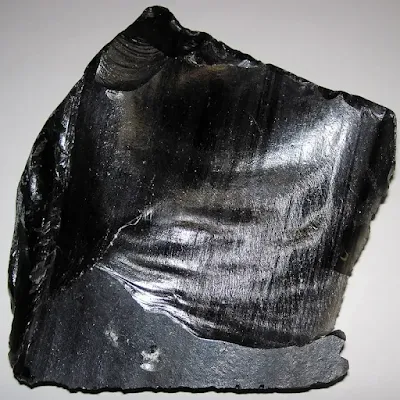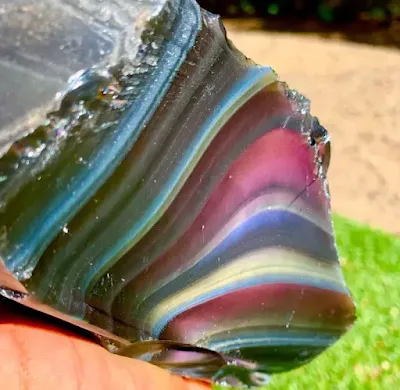Obsidian: Colors, Types of Obsidian With Photos
Obsidian is a naturally occurring volcanic glass formed when felsic lava cools rapidly, preventing the formation of crystals. Known for its smooth, uniform texture, obsidian can exhibit a variety of colors due to impurities or the presence of different minerals. Common colors include black, brown, red, and green. While black obsidian is the most typical due to its high iron and magnesium content, various impurities and inclusions can create distinctive types of obsidian, such as mahogany, snowflake, and rainbow varieties.
Obsidian
Obsidian is formed from quickly cooled lava, which is the parent material. Extrusive formation of obsidian may occur when felsic lava cools rapidly at the edges of a felsic lava flow or volcanic dome, or when lava cools during sudden contact with water or air. Intrusive formation of obsidian may occur when felsic lava cools along the edges of a dike.
 |
| Obsidian: Types, Varieties of Obsidian With Photos |
Types and Colors of Obsidian
There are many different types of obsidian, each with its own unique appearance. Some of the most common types of obsidian include:
Black obsidian
 |
| Black obsidian From Newberry Volcano (central Oregon) |
Black obsidian is the most common type of obsidian. It is typically jet-black in color, but it can sometimes have a dark gray or brown tint. Black obsidian is often used to make jewelry and sharp tools. Black obsidian is formed when felsic lava cools rapidly with minimal crystal formation. This causes the atoms in the lava to solidify into a disordered, non-crystalline structure. This gives black obsidian its characteristic glassy appearance. Read more about it here.
Mahogany obsidian
 |
| Mahogany obsidian from northwestern Wyoming, USA |
Mahogany obsidian is a type of obsidian that is red or brown in color. The geology of mahogany obsidian is similar to that of black obsidian. It is formed when felsic lava cools rapidly, but it contains more iron oxide impurities, which gives it its characteristic brown or reddish-brown color. The rich reddish-brown color of mahogany obsidian is attributed to the presence of iron oxide, commonly known as rust. Iron oxide impurities are responsible for the deep hues that set mahogany obsidian apart from other types of obsidian. These impurities can be introduced to the molten lava during the eruption process, as the magma interacts with mineral-rich rocks and sediments within the Earth's crust. Mahogany obsidian is often used to make jewelry and sculptures.
Rainbow obsidian
 |
| Rainbow obsidian from Mexico |
Rainbow obsidian is a type of obsidian that has a rainbow-like sheen. The colorful sheen of rainbow obsidian is a result of microscopic mineral inclusions within the glass. As the magma cools and solidifies, these minerals become trapped within the obsidian's structure. These inclusions can include minerals like magnetite, hematite, and feldspar, among others. The vibrant colors exhibited by rainbow obsidian are a result of a phenomenon known as structural coloration. Unlike pigments that absorb and reflect specific wavelengths of light, structural colors arise from the interaction of light with a material's microstructure. Rainbow obsidian is a very rare and valuable type of obsidian. Read more about it here.
Sheen obsidian
 |
| Polished Sheen obsidian |
Sheen obsidian is a type of obsidian that has a metallic sheen. What sets sheen obsidian apart is the presence of microscopic gas bubbles trapped within the glass during its rapid cooling process. These gas bubbles create thin layers that interact with light, giving rise to the captivating sheen or glow that characterizes this variety. The iridescent effect in sheen obsidian is caused by the interaction of light with the parallel layers of minerals or crystals within the glass. When light enters the glass and interacts with these layers, it is refracted and reflected, producing the mesmerizing play of colors that distinguishes sheen obsidian. The exact minerals responsible for the sheen can vary, but they often include magnetite, hematite, or other iron-rich minerals. Sheen obsidian is often used to make jewelry and decorative objects.
Snowflake obsidian
 |
| Snowflake obsidian from Obsidian Cliff, Yellowstone, Wyoming, USA |
Snowflake obsidian is a type of obsidian that has small, white spherulites in it. The white "snowflakes" are actually clusters of needle-like cristobalite crystals, a high-temperature polymorph of quartz. These crystals form in a radial pattern, resembling delicate snowflakes frozen in time. The formation of these crystalline structures is influenced by the interplay of mineral content, temperature, and cooling rate during the volcanic eruption and subsequent cooling process. Snowflake obsidian is often used to make jewelry and sculptures. Read more about it here.
Fire obsidian
 |
| Fire obsidian Photo: Tom Dodge |
Fire obsidian is a type of obsidian that has an iridescent sheen. Fire Obsidian, also referred to as "Fire Sheen Obsidian," is a strikingly beautiful volcanic glass that derives its vibrant iridescence from layers of nanoparticles. It forms when volcanic lava rich in silica cools rapidly, preventing the growth of large mineral crystals. During this rapid cooling process, thin layers of nanoparticles settle on the surface of the obsidian, creating the brilliant play of colors and sheen that characterize Fire Obsidian.
The colors and sheen result from the interference of light waves as they pass through these nanoparticle layers. Depending on the thickness and arrangement of these layers, different colors are reflected, producing the shimmering effect known as "fire." Fire obsidian is a very rare type of obsidian, and it is often used for jewelry and other decorative items. Read more about it here.
Apache tears
 |
| Apache tears from Arlington, VA, USA Photo: Stephanie Clifford |
Apache tears are small, teardrop-shaped pieces of obsidian that are often found in the American Southwest. Apache Tears are characterized by their smooth, rounded shape and deep black color. These nodules have been tumbled and polished by natural processes, such as water erosion, over time. They typically measure a few centimeters in size and exhibit a distinct conchoidal fracture – a smooth, curved fracture surface often seen in glassy materials like obsidian.
These nodules are composed mainly of volcanic glass, but they might also contain small amounts of mineral impurities, giving them a dark brown or reddish tint. These impurities can include minerals like magnetite, amphibole, and biotite. The teardrop shape of Apache tears is due to the way that they are formed. They are thought to form when small bubbles of gas escape from the lava as it cools. These bubbles cause the lava to form into teardrop shapes. They are said to bring good luck to the wearer.
Obsidian bombs
 |
| Obsidian bombs |
Obsidian bombs are large, jagged pieces of obsidian that were formed when lava exploded into the air. The bombs can vary in size from small pebbles to large boulders, and their shapes can range from spherical to elongated, often resembling the appearance of a bread loaf or potato.
These formations are typically black in color due to the high iron and magnesium content in obsidian. Occasionally, they may contain gas bubbles or crystals, adding to their visual intrigue. As obsidian is relatively dense and resistant to weathering, obsidian bombs can often be found scattered across volcanic landscapes long after the eruption has subsided. Obsidian bombs can be very dangerous, but they are also very valuable to collectors.
Green obsidian
 |
| Natural Green obsidian |
Green obsidian, a captivating and relatively rare variety of volcanic glass, stands out in the world of geology with its vibrant green hues and intriguing origins. It is formed when felsic lava, which is rich in silica, cools rapidly. This rapid cooling prevents the formation of crystals, and instead, the lava forms a glassy solid. The color of green obsidian is due to the presence of trace minerals such as chlorite, serpentine, and other mineral inclusions. Read more about it here.
History of obsidian
Obsidian has been used by humans for at least 10,000 years. It was one of the first materials used to make sharp tools and weapons, and it was also used for making jewelry and ornaments. Obsidian was particularly important to cultures in the Americas, where it was used by the Maya, Aztec, and Inca civilizations.
In the Americas, obsidian was traded over long distances. Obsidian from the Valley of Mexico was traded as far south as Peru, and obsidian from the western United States was traded as far east as the Great Plains. This trade network helped to connect different cultures and to spread obsidian technology throughout the Americas.
Uses of obsidian
Obsidian has been used for a variety of purposes throughout history, including:
Tools and weapons
Obsidian is a very hard material, and it can be easily flaked into sharp blades. This makes it ideal for making tools and weapons. Obsidian blades were used for cutting, slicing, and piercing, and they were also used as projectile points for arrows and spears.
Jewelry
Obsidian is a beautiful and eye-catching stone, and it has been used for jewelry for centuries. Obsidian beads, pendants, and earrings have been found in archaeological sites all over the world.
 |
| obsidian jewelry |
Ornamental objects
Obsidian can also be used to make decorative objects, such as mirrors, figurines, and sculptures. Obsidian mirrors were used by the Maya and Aztec civilizations for religious ceremonies and divination.
Traditional medicine
Obsidian has been used in traditional medicine for centuries. It is believed to have healing properties, and it is used to treat a variety of ailments, such as headaches, stomachaches, and snakebites.
Scientific applications
Obsidian is also used in some scientific applications, such as surgery and microsurgery. Obsidian scalpels are very sharp and precise, and they are used to make delicate incisions in the body. Obsidian is also used to make microtomes, which are used to slice tissue for microscopic examination.
Obsidian is a versatile and valuable material that has been used by humans for thousands of years. It is a beautiful and durable stone that can be used for a variety of purposes.
Facts about obsidian
- Obsidian is a very hard material, with a Mohs hardness of 5 to 5.5. This means that it is harder than most metals, but softer than diamonds.
- Obsidian is a very brittle material, and it can easily shatter if it is struck. This makes it a dangerous material to work with, but it also makes it ideal for making sharp tools.
- Obsidian has been used for centuries for a variety of purposes, including weapons, tools, and jewelry. It was also used by the ancient Maya and Aztecs to make mirrors.
- Obsidian is still used today for a variety of purposes, including jewelry, knifemaking, and decorative items. It is also used in some scientific applications, such as surgery and micros


%20(1).webp)





